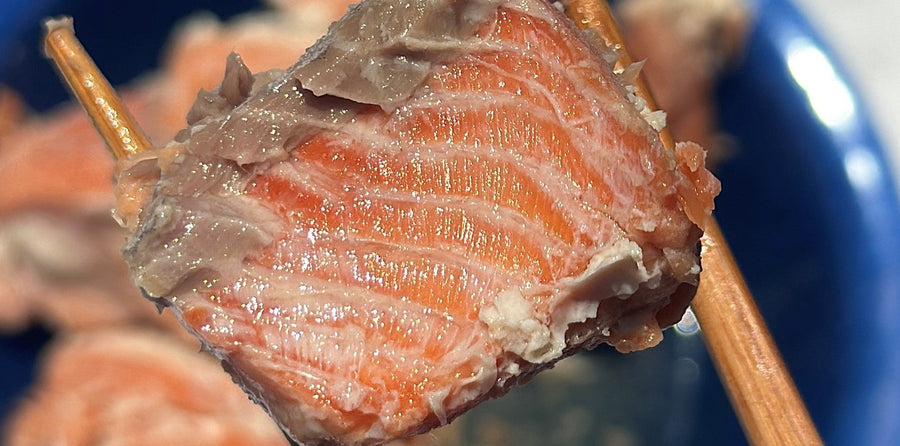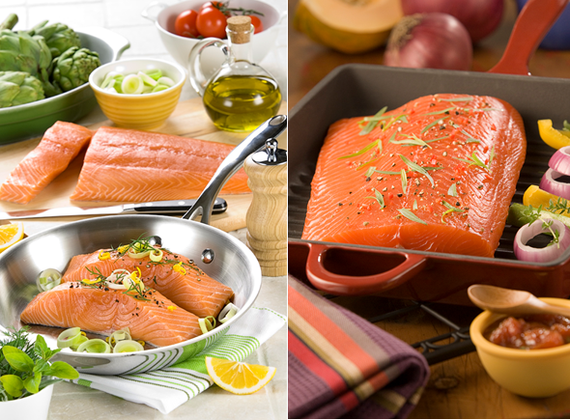
Myth 1: You have to go to a fancy restaurant to get premium-quality seafood.
Myth 2: You have to be a skilled chef to cook seafood properly.
Myth 3: You can’t pack your lunch with seafood.
Myth 4: Tinned fish doesn’t have the same amount of nutrition as its fresh and flash-frozen counterparts.
The above seafood myths are ingrained in many of our minds. If you’re a customer of Alaska Gold, you know myth 1 is false. You can get premium-quality line-caught wild Alaskan seafood— delivered to your door so that you can have five-star meals at home. We have wild salmon, halibut, black cod and more.
With the help of our recipes, you know you can scratch the second seafood myth off your list. And you’ve probably learned that using our conveniently sized portions makes cooking seafood easier than other proteins.
But maybe you’ve never thought of bringing seafood to your office in your lunchbox or packing it in your backpack for a hike.
Our canned tuna and canned salmon offer up our delicious premium-quality seafood in the convenience of a can. With our canned salmon and canned tuna, you get the best of all worlds—great-tasting seafood with unlimited culinary versatility, concentrated nutrition, and the convenience of a shelf-stable food item. This versatility makes it ideal for our busy lives and for people on the go.
And here is an added bonus, quashing seafood myth number 4 about nutrition in canned seafood: frequently the preservation process in tinned fish can enhance certain nutrients—this means that our canned salmon and canned tuna are super-nutritious and there is no concern about losing any nutritional benefits when you eat seafood in a can.
The canning process concentrates and preserves nutrients. The high-heat processing breaks down proteins into more easily digestible forms and also locks in essential vitamins and minerals that would otherwise degrade in a fresh seafood counter. Seafood has a complete amino acid profile and this becomes easier to digest with the high heat in the canning process. Heating during canning causes the protein molecules to unfold and lose their complex three-dimensional structure. This "denatured" protein is more accessible to digestive enzymes, leading to better digestibility.
There is a rumor that canned seafood loses its nutrition. (This may be in part because frozen vegetables lose nutrition because they must be blanched before freezing and canning and the blanching can take out some vitamins and minerals.) However, heart-healthy omega-3 fatty acids remain stable throughout the canning process. And as we’ve noted the protein can be more digestible, but the big deal here is that with the shelf stability gained through the canning process, you gain the convenience to take with you wherever you go or store for a long time. You can wait and serve decades later—some tinned fish afficionados even like to compare vintages, just like those who enjoy wine tasting. Here we show why we don’t put expiration dates on our canned salmon and canned tuna.
The protein content and convenience of canned salmon make it perfect for meal prepping and quick meals. We offer some fancy canned salmon recipes below, but one can easily add canned salmon as nutrition-boosting bonus to a simple pasta, a stir fry, an omelet, a sandwich, all range of salads, and of course the legendary salmon casserole.
Another added bonus is that canned salmon requires no cooking on your part—it’s already cooked. This makes it great to have on hand in case of a power outage or other emergency. It’s also good to not turn your oven on during a hot summer day and with a can of salmon you’ve got a meal. And if you’ve ever been nervous about overcooking seafood, have no fear. Our canner gets it just right. Also, there is no need to worry about planning ahead and thawing out your canned salmon--it’s ready to go when you are!
In addition to pasta dishes, we also recommend adding our canned salmon to Asian-inspired preparations with ginger, soy sauce and sesame oil. Mediterranean-inspired recipes that use lemon, olive oil and fresh herbs also work really well.
We recommend this chickpea salad with canned coho salmon recipe from our friend The Sardinfluencer, who also shares with us this yuzu miso soup with udon and canned king salmon recipe.
Canned tuna is still one of the top seafood items consumed in the United States. We still encounter folks who have had poor-quality canned tuna and assume that canned tuna all tastes like cat food. Try our line-caught albacore tuna. Our line-caught albacore tuna are handled with care, frozen-at-sea ensuring premium quality. Since they are line-caught, the tuna are actively feeding and in their juvenile stage, which means that their fat content is high and their mercury content is low. And the taste will make you a believer that canned seafood is not just something you should be feeding your cat.
We pack our canned tuna (and canned salmon) with neither water nor oil, both of which are common with grocery store canned fish. All of the oil in the can is from the tuna’s oil, so you can see right as you open the can that the oil content is high, making it delicious and nutritious.
When I joined our fishermen-owned co-op, I too thought that canned tuna was just cat food, but now I make about one tuna melt per week with our excellent canned tuna. But check out this Roasted Nightshades With Albacore Tonnato & Sichuan Chili Oil Recipe from the Sardinfluencer.
One question customers have about our tinned fish is about mercury content in canned tuna and canned salmon. All of our fish is not known as a high-risk fish for Mercury like larger predator fish (swordfish and shark, for example). Alaska is an extremely low population area. The rivers in Alaska where most of the salmon are born, reared, and eventually spawn have very few people living near them – usually towns with populations of less than 10,000 people, which makes the rivers an excellent environment for salmon to call home. Therefore, our canned salmon is very safe from mercury contamination. In addition, salmon, albacore tuna, sablefish and halibut all are high in selenium, which is an essential mineral that counteracts mercury toxicity.
Here is more information on how selenium counteracts mercury toxicity and all of the other health benefits of selenium, which include anti-virus, anti-cancer, and other immunity-boosting properties. This is an excellent summary of why healthy eaters should not limit consumption of ocean seafood over concerns of mercury contamination. The FDA acceptable limit for mercury is 1.0 parts per million, and Alaska seafood falls well below that accepted limit. In addition, our albacore tuna tested at 337ppb or 0.337ppm, well below the 1.0 ppm FDA action limit. And more information about mercury in Alaska seafood here.
Check out our canned salmon and canned tuna for delicious powerhouse nutrition in the convenience of a can.



